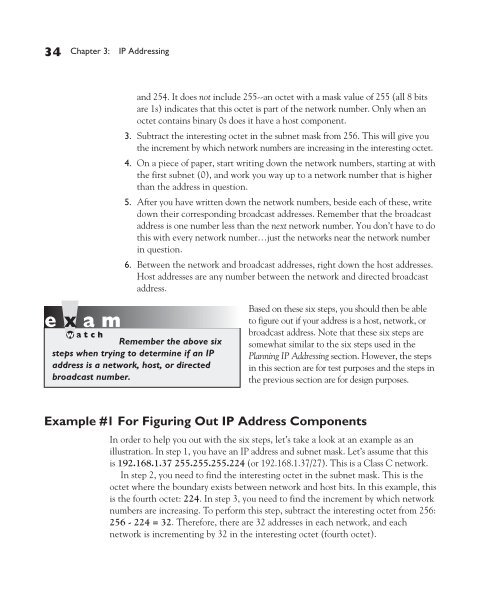ch03 IP Addressing.pdf - The Cisco Learning Network
ch03 IP Addressing.pdf - The Cisco Learning Network
ch03 IP Addressing.pdf - The Cisco Learning Network
You also want an ePaper? Increase the reach of your titles
YUMPU automatically turns print PDFs into web optimized ePapers that Google loves.
34 Chapter 3: <strong>IP</strong> <strong>Addressing</strong><br />
and 254. It does not include 255--an octet with a mask value of 255 (all 8 bits<br />
are 1s) indicates that this octet is part of the network number. Only when an<br />
octet contains binary 0s does it have a host component.<br />
3. Subtract the interesting octet in the subnet mask from 256. This will give you<br />
the increment by which network numbers are increasing in the interesting octet.<br />
4. On a piece of paper, start writing down the network numbers, starting at with<br />
the first subnet (0), and work you way up to a network number that is higher<br />
than the address in question.<br />
5. After you have written down the network numbers, beside each of these, write<br />
down their corresponding broadcast addresses. Remember that the broadcast<br />
address is one number less than the next network number. You don’t have to do<br />
this with every network number…just the networks near the network number<br />
in question.<br />
6. Between the network and broadcast addresses, right down the host addresses.<br />
Host addresses are any number between the network and directed broadcast<br />
address.<br />
Remember the above six<br />
steps when trying to determine if an <strong>IP</strong><br />
address is a network, host, or directed<br />
broadcast number.<br />
Based on these six steps, you should then be able<br />
to figure out if your address is a host, network, or<br />
broadcast address. Note that these six steps are<br />
somewhat similar to the six steps used in the<br />
Planning <strong>IP</strong> <strong>Addressing</strong> section. However, the steps<br />
in this section are for test purposes and the steps in<br />
the previous section are for design purposes.<br />
Example #1 For Figuring Out <strong>IP</strong> Address Components<br />
In order to help you out with the six steps, let’s take a look at an example as an<br />
illustration. In step 1, you have an <strong>IP</strong> address and subnet mask. Let’s assume that this<br />
is 192.168.1.37 255.255.255.224 (or 192.168.1.37/27). This is a Class C network.<br />
In step 2, you need to find the interesting octet in the subnet mask. This is the<br />
octet where the boundary exists between network and host bits. In this example, this<br />
is the fourth octet: 224. In step 3, you need to find the increment by which network<br />
numbers are increasing. To perform this step, subtract the interesting octet from 256:<br />
256 - 224 = 32. <strong>The</strong>refore, there are 32 addresses in each network, and each<br />
network is incrementing by 32 in the interesting octet (fourth octet).

















